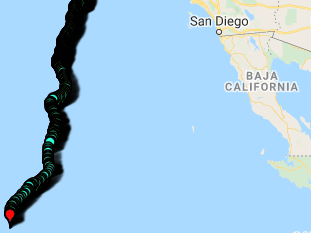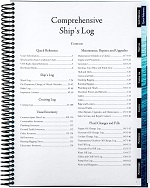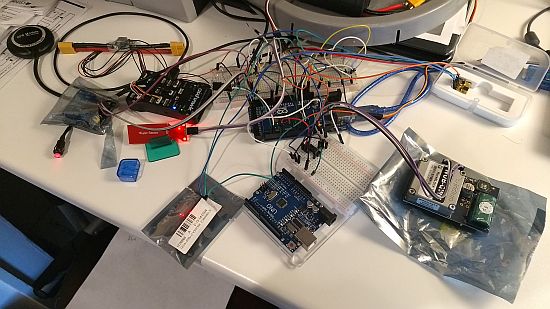Legwork for LoCARB Launch Day
Launch time, almost…
As the build on LoCARB is coming to an end, the time has come to begin the next phase of planning, for L-day!
Several factors in selecting a launch site were taken into consideration such as wave activity, current, nearby kelp/reefs, and convenience. But I think what mattered the most was the availability of a launch partner (AKA someone with a boat). Half moon bay offers an ideal mix of all of the factors and even better, actually provided me with an awesome launch partner.
Checking out the launch site, during lunch, in Half Moon Bay
Last week my wife and I stopped by Pillar Point Harbor in Half Moon Bay to grab some lunch, and as luck would have it, we met a cool dude named Kerry who lives on boat moored at the harbor. While I was walking past him he directed me to buy some crab as some individuals were selling them on the dock. But I mentioned rather than crab, I was looking for someone who could take me out in the ocean and help me launch an autonomous boat. He was immediately interested and introduced me to his friends (who also live on boats moored at the harbor), and even offered to take me out to scout the proposed launch area! With his knowledge of the bay, we chose a site to visit the next day as we were on a time crunch.
The next day…
Next day rolls around and we take Kerry up on his offer and away we go (Pictured: my wife and Kerry).
Exiting the harbor
While out in the bay, we came across a message in a bottle!
There was no location specified in the note, but it was amazing that the little bottle was floating for 6 years before being found. We promptly wrote on the back with location and contact info and tossed it back into the ocean. What a fun find!
I marked the launch area which happens to be in a channel between two reefs. There is a protected fishing area a little north from the marker with some kelp congestion, but we should be able to keep clear from it. Also, in a really neat coincidence, Damon shared that his boat Seacharger launched from the same location (although Seacharger gets more points from being launched from shore)!
It was a great way to get a feel for how the launch will take place, and I am immensely grateful to Kerry for offering to take us out.
Lake Merced Test #3
It was a quick trip out in the bay and we promptly returned home to test LoCARB at Lake Merced immediately after.
This day was to be spent checking buoyancy and balance after dissolving almost all the foam left in the motor pod cones and testing navigation and satellite communication with the solar panel completely mounted. However, after only 1.5 hours of doing so, LoCARB went out of range of the RC transmitter (which was used as a failsafe in case I needed to manually control the boat) which introduced errata into the signal and triggered the flight mode to manual control and out of auto mode. This was problematic as since the RC transmitter was out of range, the boat was now just driving around aimlessly with the rudder moving randomly as well. It eventually ended up clear across the lake in a marshy area covered in tall grass where I couldn’t physically reach. I tried driving around the lake and hacking through the growth but the waters edge came up farther on the shore than where the boat was located. I couldn’t even see the boat unless standing where the boat was launched, on the other side of the lake. To make matters worse, I had a meeting to attend and I had to leave the boat stranded there for over 3 hours till my meeting ended. I literally felt like I left one of my children alone at the park unattended, what a stressful situation.
Boats location circled in white
It was at this time where I sent a satellite message to LoCARB to disable the motor, which turned out to be a good move.
While checking on the location of the boat I noticed that with the motor off, the boat dislodged itself from the weeds and drifted around the lake for the 3 hours I was gone. This actually brought the boat closer (red pin on image below) to the launch site (left-most green area near the bottom of the lake), which allowed for an easier recovery by Dragonboat team).
After the meeting, I rushed back to the lake and was greeted by all the High School Dragonboat teams in San Francisco prepping for their practice. This was a blessing as after a quick chat with the Lowell high school Dragonboat coach, a rescue operation was underway.
Commence Rescue Mission
Rescue mission complete!
LoCARB safe!
I think the highlight of that whole experience was hearing the collective “whoaaa” from the students as we lifted the boat out of the water and they saw the motor pod attached to the boat (since its not visible from above). The coach asked me what it was as well. I didn’t have the heart to tell him that it was way bigger and more inefficient than it should be ha ha.
False Failure
When LoCARB was loaded back up and testing was done on its prop assembly, I realized I couldn’t turn it easily by hand. I almost called the project a failure at that point thinking the magnetic coupling barrier finally failed, but upon further inspection it turned out it was dirt and sediment packed into the ceramic bearing. After some wiggle-waggling under water, the bearing was good as new and the prop shaft moved as before. WHEW! This confirmed that although kicking around in dirt and weeds, the magnetic coupling was at least robust enough to not self-destruct, but also tipped me off to sediment fouling. I hope its not going to be an issue as there shouldn’t really be any grit/sand floating on the water in the ocean right?
Some neat little experiences
There were a few takeaways from this day:
- People are genuinely interested when they see technology being utilized in interesting and unique ways. When I first dropped LoCARB into the brackish Lake Merced water, a man came up and was really interested in how it was solar powered and shared his RC experiences. Its interesting how projects like these bring people together.
- Although 3D printed, the magnetic coupling is much more robust than I thought.
- Tuning a boats autopilot with Ardurover is much more difficult than anticipated. I still haven’t completed it!
- Support and friendships (even virtually) make projects like this much better. A few emails back and forth with the creator of Seacharger and I have a better grasp of how to tune PID (thanks Damon!).
All in all, this specific day in LoCARB history was memorable – not only for the range of emotions generated by the successes and failures of the project, but by the meeting of unique and amazing everyday people and the sharing of life that goes with reaching out and engaging with them. Opportunity to connect is everywhere!














